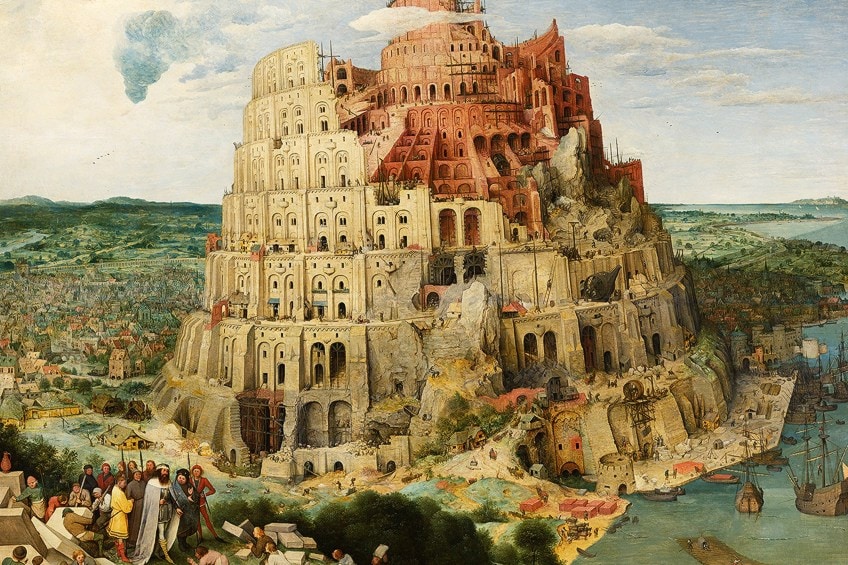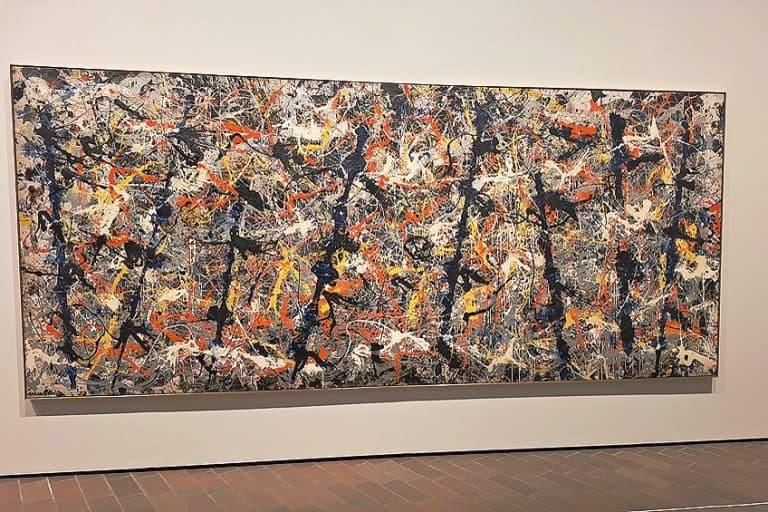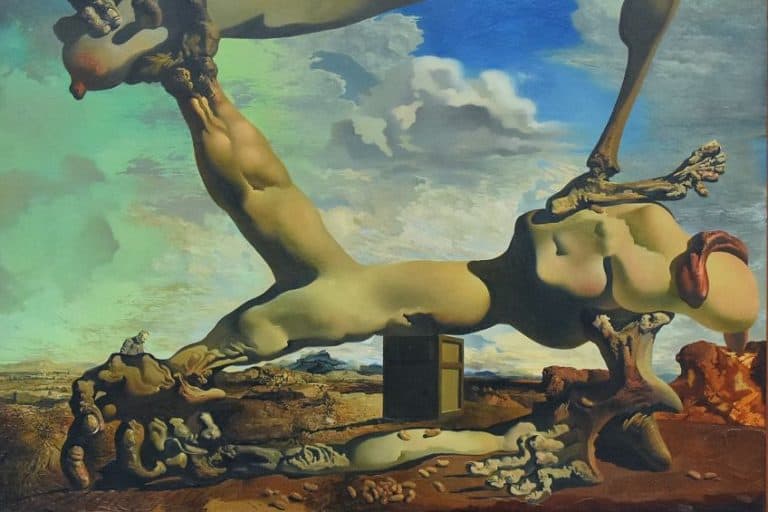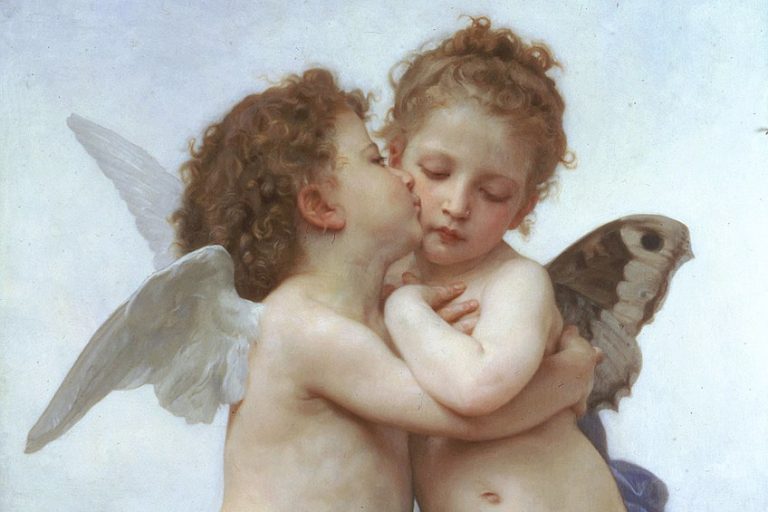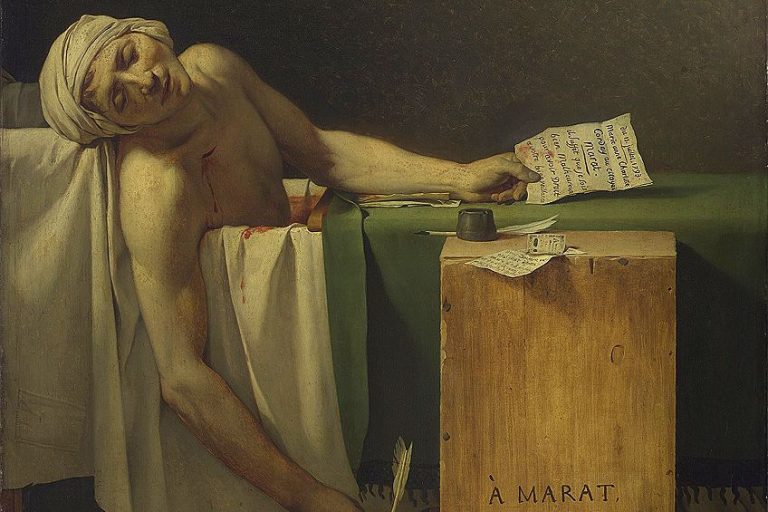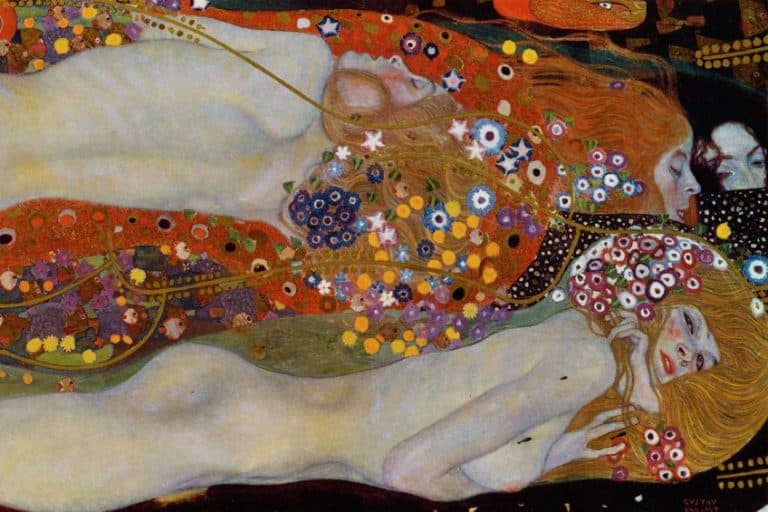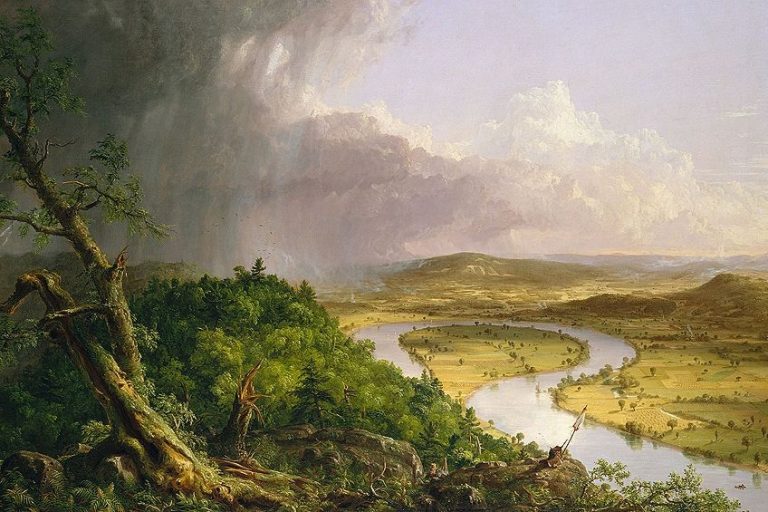Bruegel Paintings – Exploring the Art of Pieter Bruegel the Elder
The Italian Renaissance period is well remembered for its focus on portraying religious and mythological scenes of heroes and saints. But we also have the Northern Renaissance period that took place during the early 1400s, mostly in the Low Countries and countries like Switzerland, Austria, and Germany. Artists focused on subject matter differently in the Northern regions, depicting scenes of everyday life and people. Among these artists was the popular Pieter Bruegel the Elder, or as some would call him “Peasant Bruegel” or “Pieter the Droll”, whose paintings we will discuss below.
Who Was Pieter Bruegel?
Not a lot is known about the Northern Renaissance painter, Pieter Bruegel the Elder. He was a Flemish artist believed to be born between 1525 to 1530 in the city called Breda, located in the southern regions of the Netherlands. He was thought to be from a peasant family, but some scholars attest that he was a learned man. He was apparently mentored by the Flemish artist Pieter Coecke van Aelst. In 1551, in Antwerp, Bruegel also received the title of Master in the Guild of Saint Luke.
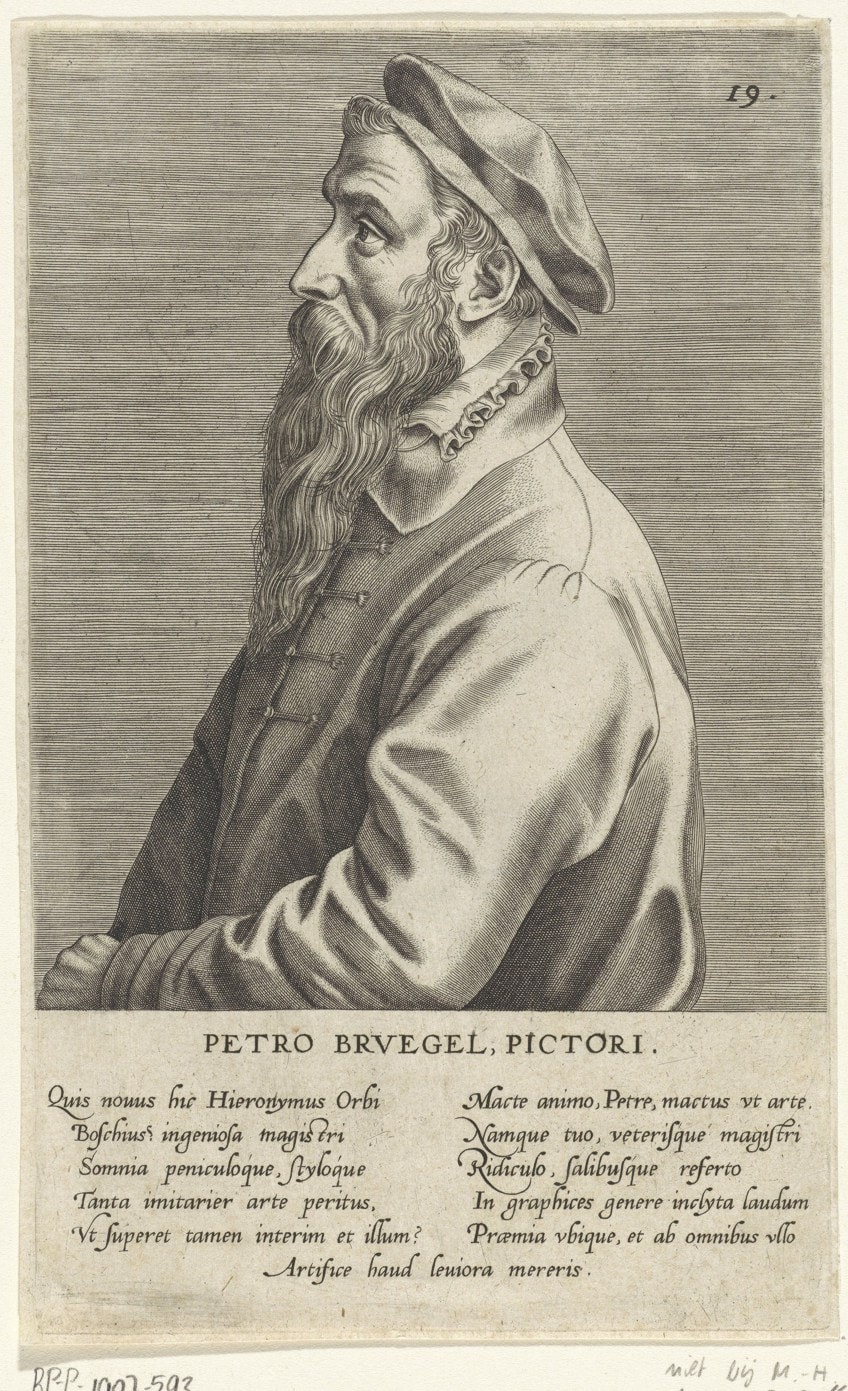
He was greatly influenced by the Swiss Alps on his travels and painted these landscapes. Bruegel also worked as an engraver for Hieronymus Cock and is known for creating humorous artworks. Bruegel married Mayken Coecke, Pieter Coecke’s daughter, in 1563 and had two sons and a daughter. His sons were Pieter Brueghel the Younger and Jan Brueghel the Elder. There is not a lot of information about his daughter, but his sons became famous artists continuing the legacy. Bruegel died in 1569 in Brussels, where he also lived with his family.
Top 10 Famous Pieter Bruegel Paintings
Below, we look at 10 examples from the Pieter Bruegel artwork collection around the world. It will show us his primary themes revolving around everyday people, scenes of peasants, landscapes, the seasons, and various celebrations, which compares to the more traditional subject matter we see in Italian Renaissance paintings of mythological and religious characters.
However, it should be noted that Bruegel also painted subject matter with religious themes as well as political and social themes. His work is often described as focusing on the collective aspects of humanity rather than the individualized aspects.
Bruegel was a master at genre paintings and executed these with great stylistic skill. The unique portrayal of perspective and scale is one of his primary characteristics.
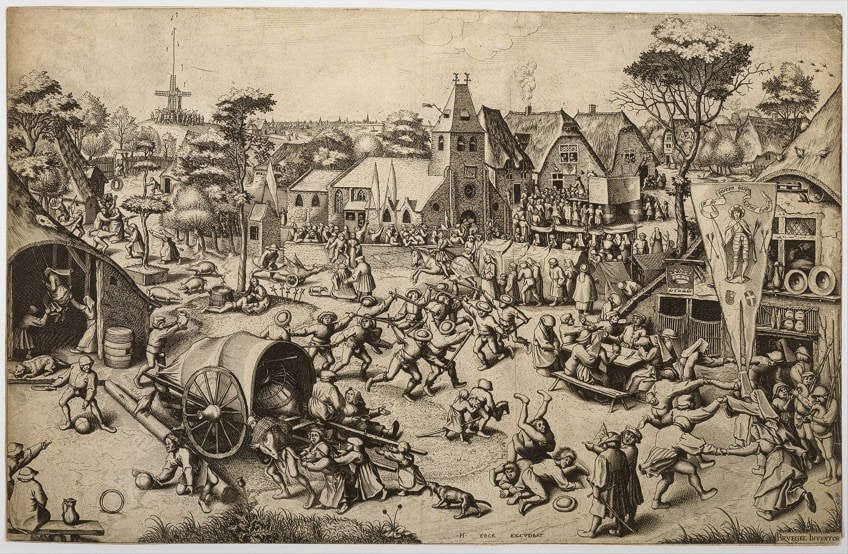
We will notice in many of Bruegel’s artwork mentioned below that he zooms in on a scene, almost like a bird’s eye view, and his characters are smaller and distributed filling up the compositional space. The scenes are also typically about the figures going about their daily activities or festivities, for example, hunting, cooking, playing, dancing, farming, and more.
The everyday folk people appear preoccupied with what they are doing – there is almost a sense of disconnect between them and how they are placed amongst each other.
The Fall of Icarus (c. 1558)
| Title | The Fall of Icarus |
| Date Painted | c. 1558 |
| Medium | Oil on canvas |
| Dimensions | 73.5 x 112 centimeters |
| Where It Is Currently Housed | Royal Museums of Fine Arts of Belgium, Brussels |
The originality of The Fall of Icarus (c. 1558) has been widely debated as some believe this may not have been painted by Pieter Bruegel the Elder, but by another artist, however, the subject matter is regarded as his. This is also only one of a couple of Bruegel paintings with a mythological theme.
It depicts the story of the mythological character Icarus who wanted to fly, taken from the Roman poet Ovid’s narrative poem Metamorphoses (8 AD). Icarus’ father, Daedalus, warned him to not fly too close to the sun as his wings were made from beeswax and feathers. Not listening to his father, his wings melted, and he plummeted to his death.
Bruegel’s painting depicts the moment Icarus fell.
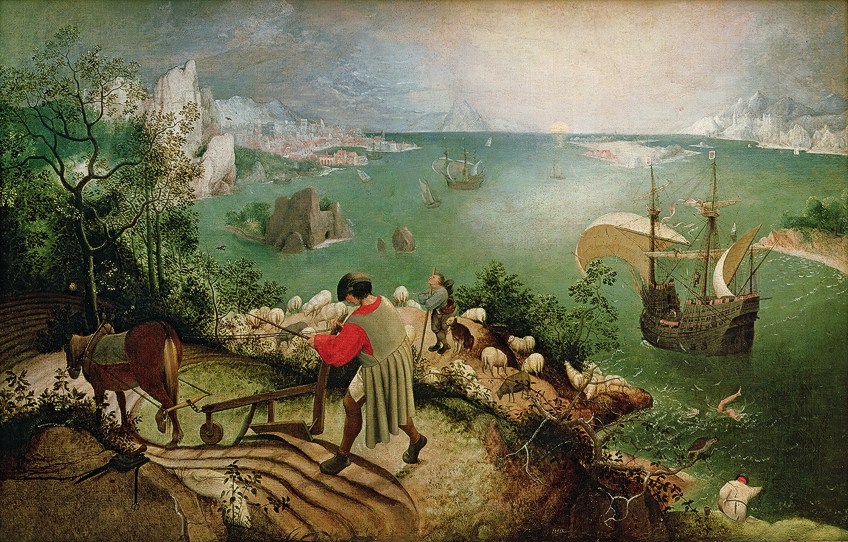
When we view the painting, we might wonder where Icarus is portrayed because we are met with an entire scene of everyday life. There is a hilly landscape in the foreground, making up two plateaus, with the background making up a large expanse of the ocean with two large ships and two smaller boats appearing to sail towards the distant city port to the left.
There is a figure with a plow and horse walking to the left side on the top part of the hilly foreground and on the lower level we see a shepherd with numerous sheep. On the bottom right corner, we see a fisherman sitting with his fishing rod in his outstretched right hand with a large bird of prey closely above his left shoulder sitting on a tree branch.
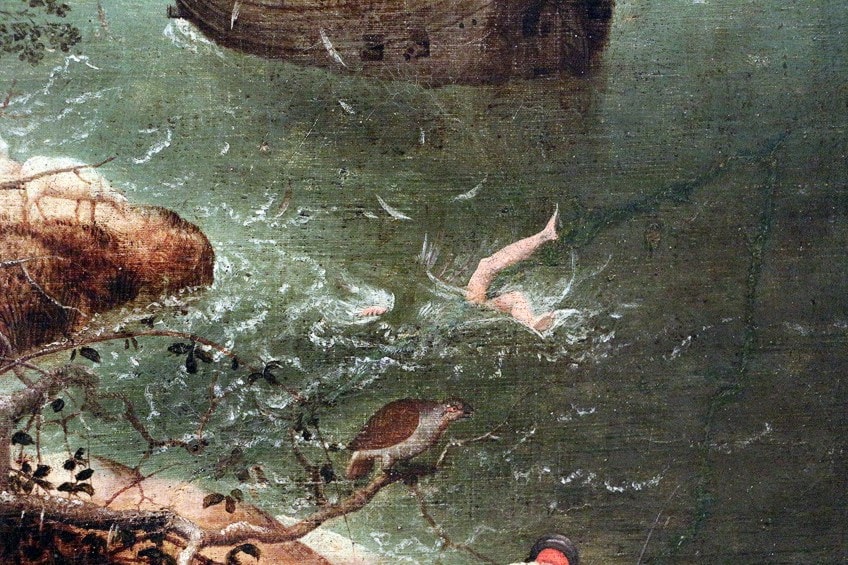
In the bottom right foreground in the ocean, not very far from the fisherman, we notice two legs protruding upwards from the water. This is our main protagonist, Icarus. Bruegel depicted him in a comical manner, a unique style we see from the artist. He placed him in an everyday scene and did not focus on his fall as the main focal point of the painting.
It is believed this painting also depicts the Dutch saying, “one does not stay the plow for one who is dying”.
The Fight Between Carnival and Lent (1559)
| Title | The Fight Between Carnival and Lent |
| Date Painted | 1559 |
| Medium | Oil on panel |
| Dimensions | 118 x 164 centimeters |
| Where It Is Currently Housed | Kunsthistorisches Museum, Vienna |
In Bruegel’s painting The Fight Between Carnival and Lent (c. 1559) we see around 200 figures filling the composition. The angle is that of an aerial view. All the figures in this painting are busily going about their business, but what business are they going about? This is a depiction of two festivals, namely, the Carnival festival of Mardi Gras and that of Lent. Carnival lasts from the 12th day of Christmas, also referred to as the Epiphany, to the day before Ash Wednesday, which is known as Mardi Gras.
The term “Mardi Gras” is of French origins translating to “Fat Tuesday”. Lent starts with Ash Wednesday.
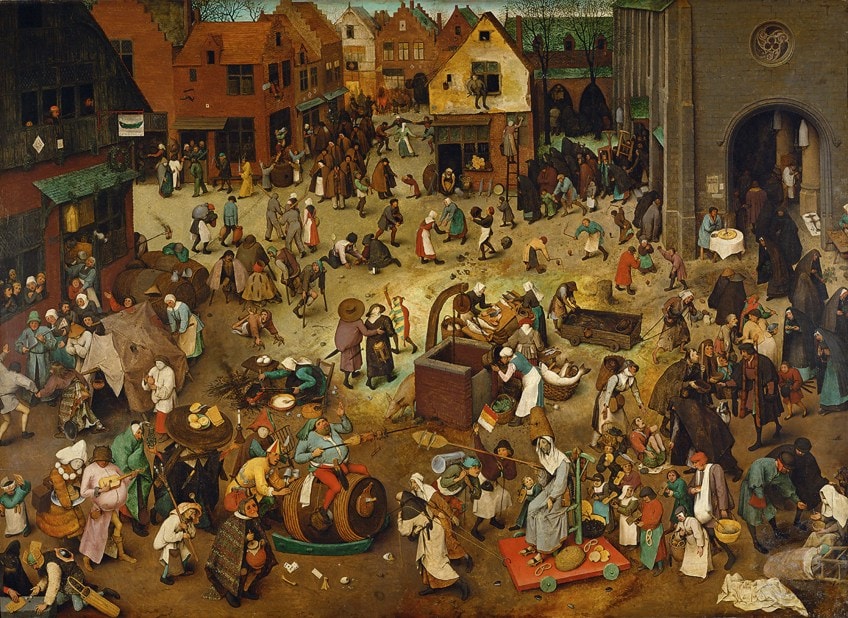
Bruegel certainly illustrated the richness of festivities related to both important religious seasons, showing the stark differences between the two. The former is about festivities and feasting and the latter, Lent, is more serious and about contemplation and fasting.
The artist also depicted an Inn on the left of the composition and a church to the right.
While there are hundreds of people in this composition, each signifying his or her own part in either the Carnival or Lent. We notice figures packing the Inn to the left and walk outside in joyous dispositions and juxtaposed to them we notice figures walking in and out of the church wearing liturgical garments.
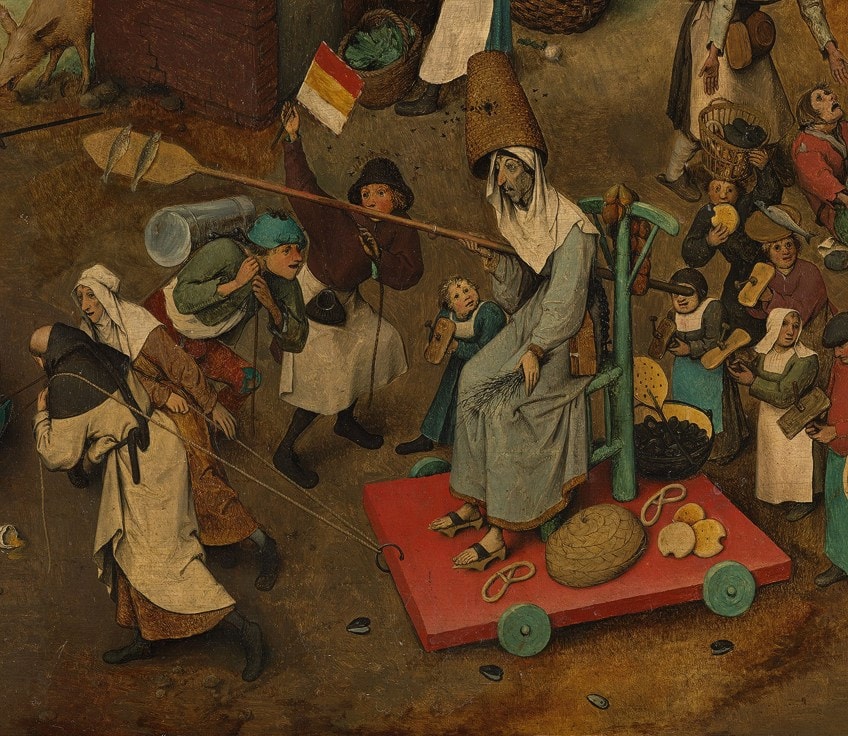
What is unique about Bruegel’s painting here is how he portrayed each figure with complete human qualities, as symbols of the different virtues. We see elements of piety, sin, pain, pleasure, and judgment, among others.
Furthermore, Bruegel depicts this scene with keen attention to detail.
The Netherlandish Proverbs (1559)
| Title | The Netherlandish Proverbs |
| Date Painted | 1559 |
| Medium | Oil on panel |
| Dimensions | 117 x 163 centimeters |
| Where It Is Currently Housed | Gemäldegalerie, Berlin |
In The Netherlandish Proverbs (1559) Bruegel depicts, as the title suggests, Dutch proverbs, only here these are personified through the multitudes of figures – from humans, animals, and objects – displayed. This painting was also titled The Folly of the World or The Blue Cloak. The proverbs all touch on human behaviors, and often about the “follies” of how humans behave.
Bruegel gives us a lot to look at, over 100 proverbs, and again demonstrates his attention to detail as an artist.
If we look at a few examples, starting from the lower left of the composition, we see a woman tying a devil to a pillow (“To be able to tie even the devil to a pillow”), which means obstinacy or stubbornness can overcome anything; a man biting a pillar (“To be a pillar-biter”), which means hypocrisy in religiousness; a woman carrying a bucket of water and a firing piece of coal (“Never believe someone who carries fire in the one hand and water in the other”), which means someone is two-faced, and a man beating his head against the wall (“To bang one’s head against a brick wall”), which means trying to do something that seems impossible.
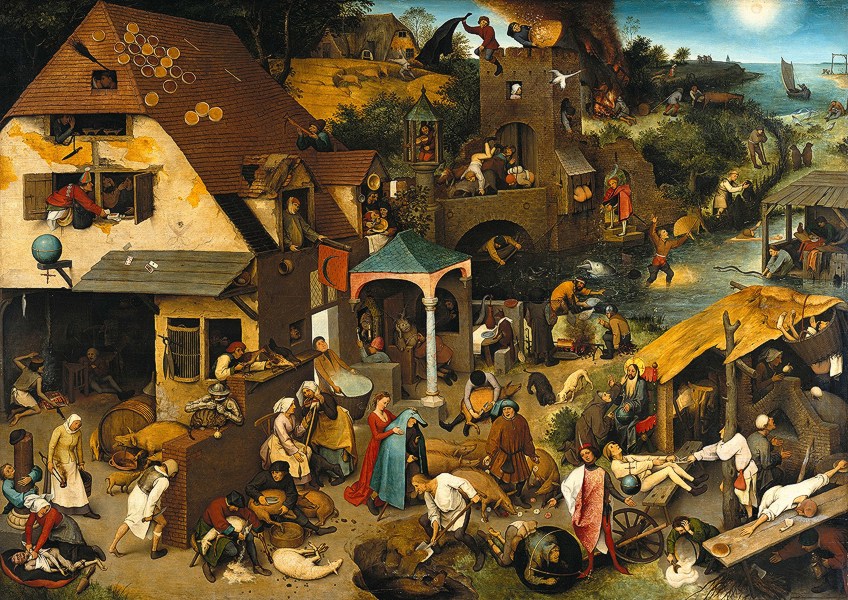
In the center we see a woman placing a blue cloak over a man, alluding to the proverb of a wife deceiving her husband, otherwise known as making him the cuckold. In the top part of the composition, we see two figures; one is tossing feathers in the wind, which means to work without any results, and the other is hanging his cloak up to the wind, which means to be adaptable in viewpoints or to change your mind easily.
We will also notice numerous tarts on the roof of the house to the left, alluding to “have the roof tiled with tarts”, meaning wealthiness. In the far background, we see a ship sailing, which also alludes to “keep one’s eye on the sail”, meaning to be attentive and careful about something.
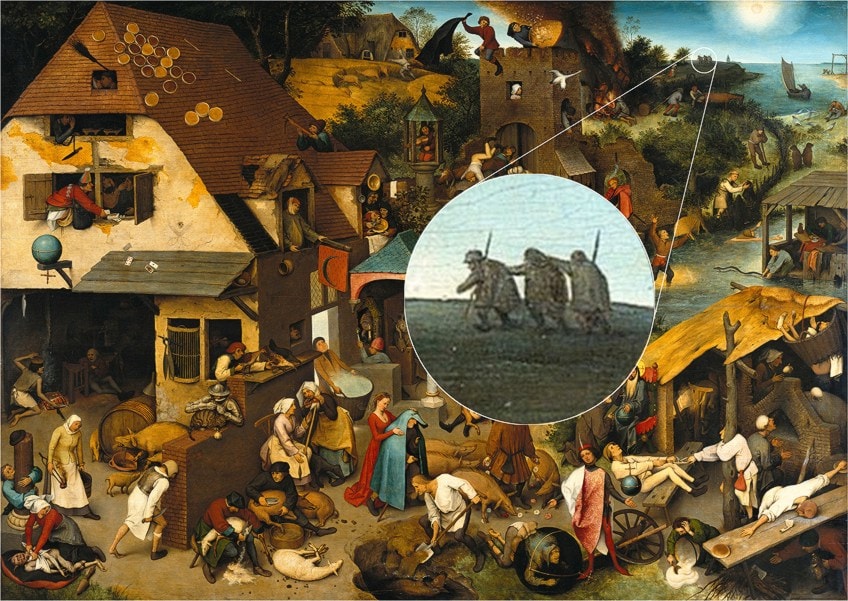
There are other paintings by Bruegel where he explores the topic around Proverbs, these include his Big Fish Eat Little Fish (1556) and Twelve Proverbs (1558). However, it is believed that The Netherlandish Proverbs is created on a larger scale.
This painting also influenced other artists to portray similar scenes.
For example, the American artist T.E. Breitenbach painted Proverbidioms (1975), which depicts around 300 different proverbs, idioms, and other sayings, a striking similarity to that of Bruegel’s work, but understandably so as Bruegel inspired Breitenbach. Other examples include the indie-folk band, Fleet Foxes, from Seattle, who used Bruegel’s painting as their first album cover.
Triumph of Death (1562)
| Title | Triumph of Death |
| Date Painted | 1562 |
| Medium | Oil on panel |
| Dimensions | 117 x 162 centimeters |
| Where It Is Currently Housed | Museo del Prado, Madrid |
In Triumph of Death (1562) we see a landscape filled with Bruegel’s usual dispersal of figures, although here we notice a more somber setting with the figures of skeletons pillaging land and what appears to be parts of a village. We also see dying and fighting human figures scattered around the composition. This is a battle between an army of skeletons and humans, but the composition touches on a deeper theme.
This is death coming for everyone, symbolized by the skeletons. We see all types of people ushered by death, for example, peasants, noblemen, women and children, soldiers, and even what appears to be the king in the lower-left corner of the painting with a skeleton holding an hourglass up in his left hand. The king’s left hand vainly reaches out to barrels of gold next to him and a skeleton is reaching into the coins with cupped hands.
There is a lot happening in Bruegel’s painting and it will require a few minutes of scrutiny to uncover all the meaningful narratives presented here.
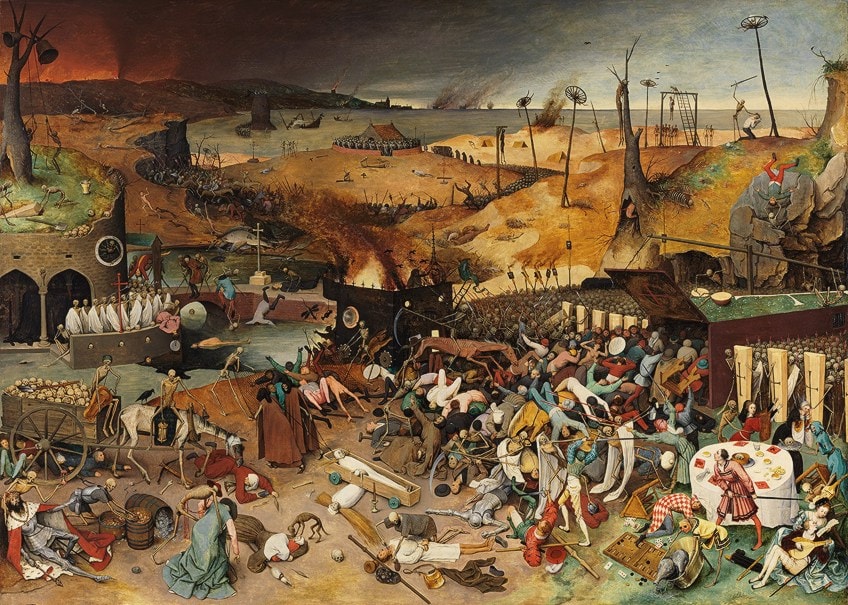
We will notice a lot of life and animation in this painting despite the allusion to death. The skeletons become almost humorous in the way they are portrayed; however, this is somber humor if you look closely as it ultimately touches on human existence and the ending of it – no matter who you are.
We will also notice dogs and horses scattered around the composition, all appearing wraith-like and very near to death themselves. Some dogs are sniffing at the dead human bodies and some horses drag a cart along or are galloping. We also notice numerous everyday objects in the composition like a backgammon board game.
This painting was created during the 16th century and many people during this time undoubtedly had fears about dying especially with the plague breaking out.
This painting by Bruegel is possibly a visual portrayal of the plague, taking its victims indiscriminately. Furthermore, there is a mocking tone to the way the skeletons are taking their victims as if there is ultimately no hope of coming out of this alive.

For example, the bottom right corner depicts a man and a woman engaging in music, possibly their last pastime before the inevitable. The man plays the lute, and the woman is holding what is possibly a music book and singing. Behind them a skeleton sits and plays the violin as if everything is okay – does the couple know the skeleton is there and their impending fate?
We also see a skeleton emptying water pitchers from a tub, however, it is wearing a mask that can either belong to the court jester we see with a red and white diamond-shaped patterned outfit finding refuge under the table, or the mask can be from a human’s face.
This painting was also influenced by the Medieval era’s genre called Dance of Death or “Danse Macabre”, which focused on depicting death personified to highlight its importance and inevitability.
The Tower of Babel (1563)
| Title | The Tower of Babel |
| Date Painted | 1563 |
| Medium | Oil on panel |
| Dimensions | 114 x 155 centimeters |
| Where It Is Currently Housed | Kunsthistorisches Museum, Vienna |
In this painting from 1563, we see a very intricately designed tower, although it is skew, that has a close resemblance to the Roman Colosseum, a structure Bruegel witnessed first-hand during his travels to Rome. The Colosseum was a building of contestation for Christians when it was constructed during 80 AD because it represented human pride and vanity. This is a theme Bruegel explores here.
This is one of Bruegel’s most popular paintings and is one of three others the artist created that explore the theme of the Tower of Babel.
In the bottom left corner, we see different figures, namely, the king and the builders discussing the tower, which looms straight ahead, a bit askew. Surrounding the tower are ships, building materials, and other builders still in the process of building the tower. There is a vast and flat landscape in the background emphasizing the magnitude of the protruding tower.
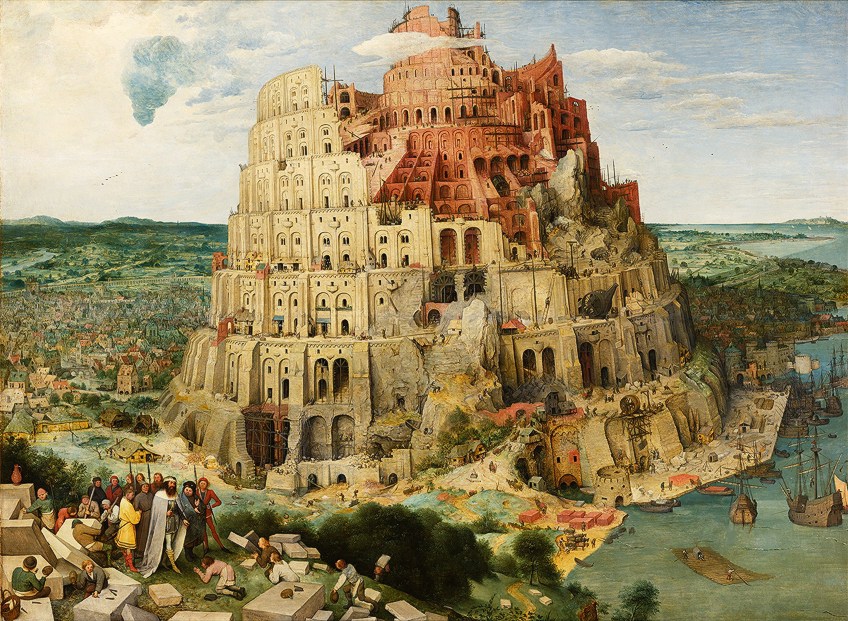
The Tower of Babel alludes to various narratives, Biblical and political. Taken from the Biblical story in the Book of Genesis when Nimrod rebelled against God and constructed the Tower of Babel. The political narrative alludes to the religious and political events during the time Bruegel lived, namely, the schism between the Catholic Church and the Protestants.
This painting touches on very prominent aspects of life and human interactions, namely, the idea of ego, power, ambition, rivalry, and the division of structures within a society.
The Harvesters (1565)
| Title | The Harvesters |
| Date Painted | 1565 |
| Medium | Oil on wood |
| Dimensions | 119 x 162 centimeters |
| Where It Is Currently Housed | Metropolitan Museum of Art, New York |
| Series | Part of a series of six paintings |
The Harvesters (1565) is part of a series of six paintings (of which only five have survived) by Bruegel focusing on the different times and seasons of the year. This painting explores the harvest season of late Summer, which is around July and August.
The other four paintings in this series are The Gloomy Day (1565), which is based on the spring months of February and March; The Hay Harvest (1565), which is based on the summer months of June and July; The Hunters in the Snow (1565), which is based on the winter months of December and January, and The Return of the Herd (1565), which is based on the autumn months of October and November.
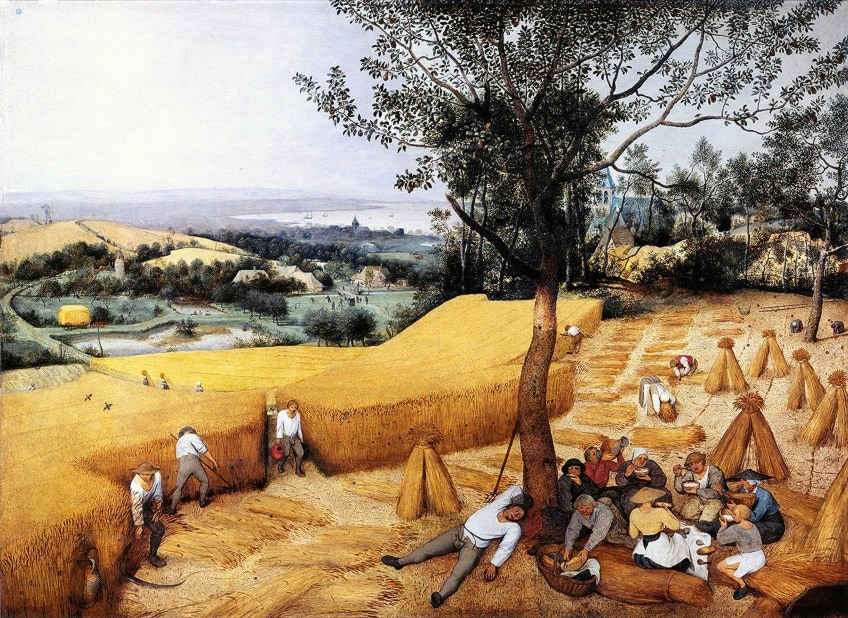
The Harvesters painting was commissioned by the banker and art collector from Antwerp, Nicolaes Jonghelinck. As mentioned above, the painting depicts late Summer. We see figures of peasants working in golden fields of wheat and the main group sitting under a tree in the bottom right portion of the composition, they are eating, drinking, and sleeping.
Bruegel depicted this painting in a significant amount of detail.
If we inspect the painting closely, we will notice the man leaning against the tree in the foreground is staring straight at us, the viewers, while he is taking a bite out of his bread or pie. In the far background, in the center-left, there is also a game of Cock Throwing taking place, which was a blood sport during the 16th century.
The Hunters in the Snow (1565)
| Title | The Hunters in the Snow |
| Date Painted | 1565 |
| Medium | Oil on panel |
| Dimensions | 117 x 162 centimeters |
| Where It Is Currently Housed | Kunsthistorisches Museum, Vienna |
The Hunters in the Snow (1565) is one of the other seasonal paintings in the Pieter Bruegel artwork series. We see a wintery 16th-century wonderland. Starting from the left we are introduced to three figures and their pack of dogs seemingly returning from a hunting excursion – all of them, including the dogs, appear subdued and laden with the disappointment of a minimal hunt, all we see is the body of a dead fox over the one figure’s back.
The hunters are making their way down a snowy hillside towards a village ahead where we also see numerous figures ice skating and playing ice hockey. There are crows perched in the trees in the foreground and a magpie is flying overhead across the center of the composition.
Magpies are symbolic of the devil in the Dutch belief system. Furthermore, we will notice these birds in other Bruegel paintings, and he reportedly depicted these to indicate ill-omens.
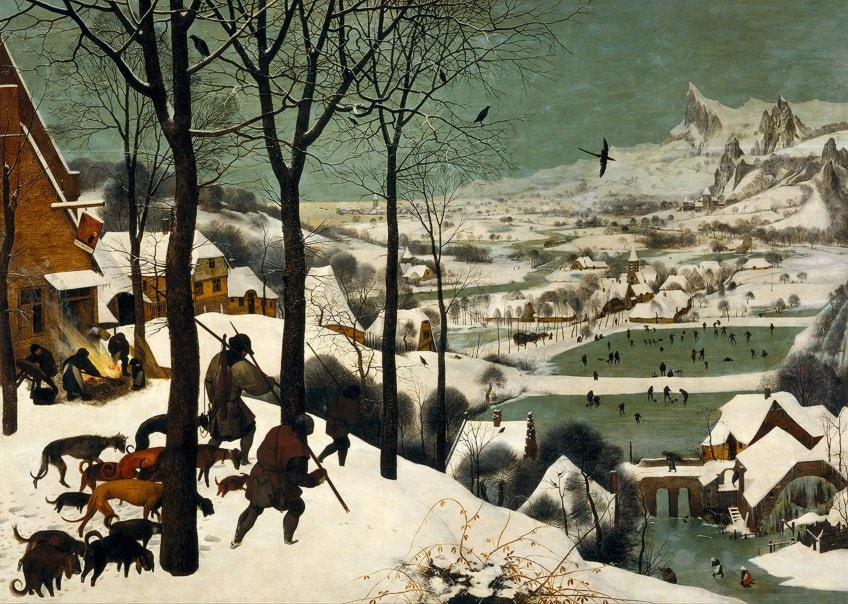
The painting has been described as appearing “calm” even though it depicts a cold and wintery day and the colors Bruegel utilized are whites and green-grays. All the people appear to be going about their business despite the icy conditions and furthermore, they all appear filled with life despite the bleakness we would associate with winter.
Bruegel utilizes an aerial view again and we view the entire painting from an elevated vantage point.
Furthermore, the artist placed various horizontal and vertical lines, especially the way we are led downwards into the village below. This starts with the verticality of the four trees in the foreground leading our eyes downward. In the distant background, there are horizontal elements from the bridges and spaces between the iced-over lakes.
Winter Landscape with Skaters and Bird Trap (1565)
| Title | Winter Landscape with Ice Skaters and Bird Trap |
| Date Painted | 1565 |
| Medium | Oil on panel |
| Dimensions | 37 x 55.5 centimeters |
| Where It Is Currently Housed | Royal Museums of Fine Arts of Belgium, Brussels |
Winter Landscape with Ice Skaters and Bird Trap (1565) is another wintery wonderland of Bruegel’s. Dominating most of the left of the painting there is a frozen river winding its way into the distance. There are figures happily skating on the river seemingly unperturbed about the cold conditions.
Flanking the river are various village houses topped with snow. The receding background fades into the foggy snowy weather. We will notice Bruegel’s familiar crows perched on the tree branches and a bird trap in the bottom right corner of the composition. There is also a hole in the ice near the foreground of the river.
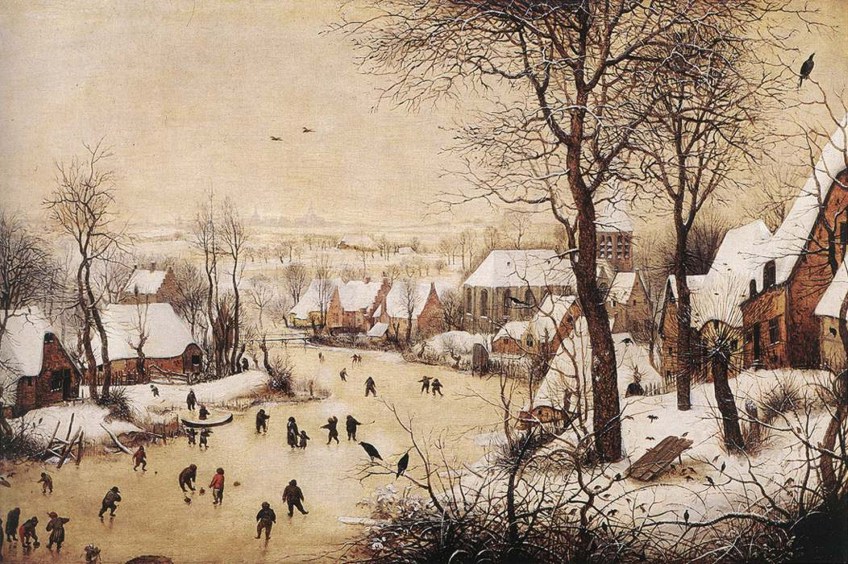
Some sources also suggest that this painting symbolizes aspects of human life and its uncertainty. Some of the motifs like the bird trap suggest elements of being baited by the devil, especially that of devout human souls. The frozen river with the gaping hole also suggests the danger of life.
Collectively, the birds and the people on the river are susceptible to potential dangers.
There were reportedly numerous copies made of this painting and it is believed it could have been a copy of an original made by Bruegel the Elder; some copies were also made by his son Pieter Brueghel the Younger. The scene is also reportedly based on a real location called Brabant Village of Zeeland in the Netherlands.
The Wedding Dance (1566)
| Title | The Wedding Dance |
| Date Painted | 1566 |
| Medium | Oil on panel |
| Dimensions | 119.4 x 157.5 centimeters |
| Where It Is Currently Housed | Detroit Institute of Arts, Michigan |
| Series | Part of other two celebratory paintings |
The Wedding Dance (1566) painting is part of Pieter Bruegel’s other two paintings, which apparently make a set, namely, The Peasant Wedding (1567) and The Peasant Dance (1569). In the painting here, we are met with hundreds of joyous peasants dancing, kissing, eating, and drinking in celebration.
Depicted is a wedding occasion that has everyone filling up the compositional space.
We know it is a wedding scene if we look at the dress of the time. The brides apparently wore black on their wedding days and the men wore crotch coverings called codpieces. All the other guests are also richly clad in the typical dress style of the 16th century.

In the foreground we see figures stomping their feet, hands on their hips, some with their backs facing us, and some facing us, but completely lost in the moment. The musician is playing the bagpipes, also called a pijpzak, in the bottom right corner. Not too far from the musician, we see a man standing, quietly observing everyone.
In the far background, we see two people kissing, and to the right, we see a round table with people in animated conversations. In fact, the entire scene is animated and lively and has been described as “oversexed”. This is a common theme in this painting, representing reproduction and vitality.
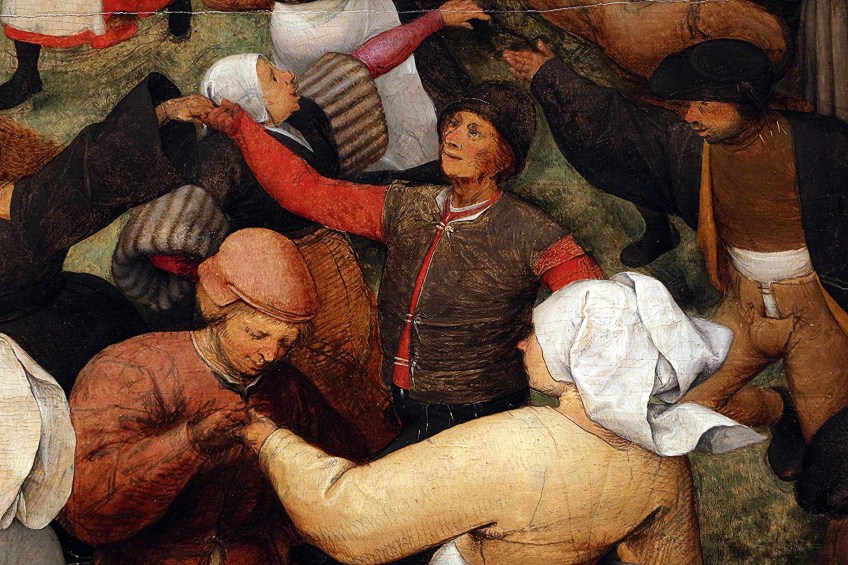
This painting has also been regarded as a unique depiction of peasants who are all moving against the constraints of the time and the rules governing the code of conduct, especially the act of dancing, which was considered wild. Furthermore, when it came to depicting peasants in paintings, this was not very customary compared to the subject matter depicted in Renaissance paintings. Bruegel has been remembered as being one of the first artists to represent the inner and working lives of peasants.
References have been drawn to the 19th-century Realist artist Gustave Courbet, maybe we can say he was a Pieter Bruegel painter or inspired by his style, as so many other artists were.
The Peasant Wedding (1567)
| Title | The Peasant Wedding |
| Date Painted | 1567 |
| Medium | Oil on panel |
| Dimensions | 114 x 164 centimeters |
| Where It Is Currently Housed | Kunsthistorisches Museum, Vienna |
| Series | Part of other two celebratory paintings |
The Peasant Wedding (1567) is another part of the celebratory Bruegel paintings, although here we are partaking in a wedding feast. We see in this painting the bride sitting against the green cloth hanging on the wall to the right of the composition. There is a crown above her head, made of paper.
In the near foreground, two men are carrying bowls of food for the people. The food would have consisted of porridge and soup.
The people are all sitting by a large, and what seems to look like, elongated table. Everyone is engaged in conversation and merriment. We see the masses of people moving all the way to the doorway in the far distance of the interior space, which is a barn. To the left, we see a man pouring beer from a pitcher and a young child sitting quite indifferently licking a plate. There is a man to the far right feeding a dog and two musicians playing the Flemish bagpipes.
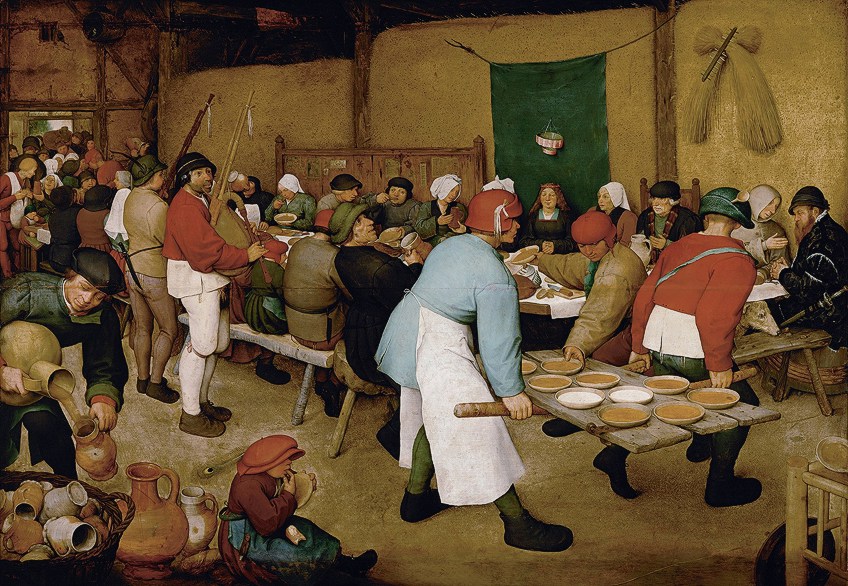
Bruegel depicted a typical wedding feast scene we would see in the 16th century, complete with the lack of the groom joining in the feast, as was customary in Flemish culture. The groom is believed to be one of the men, either the man pouring beer or the man with the red cap on his head serving the food.
However, customary rules also point out that the groom would have attended only in the evening, and the painting is depicted as taking place during the daytime as we notice from the small sliver of light by the entranceway in the back.
Bruegel Breaking Barriers
The Dutch Golden Age during the 1600s was influenced by Pieter Bruegel and the way he painted scenes of everyday people, especially peasants. We will find Peter Paul Rubens was an example of a Pieter Bruegel painter following and inspired by his artistic style.
Pieter Bruegel the Elder gave us an intimate and in-depth look into the lives of peasants, the landscapes of Northern Europe, and other aspects of the 16th century that we just did not see in paintings done during the Italian Renaissance. Bruegel elevated the peasants in his paintings and gave them a platform of remembrance.
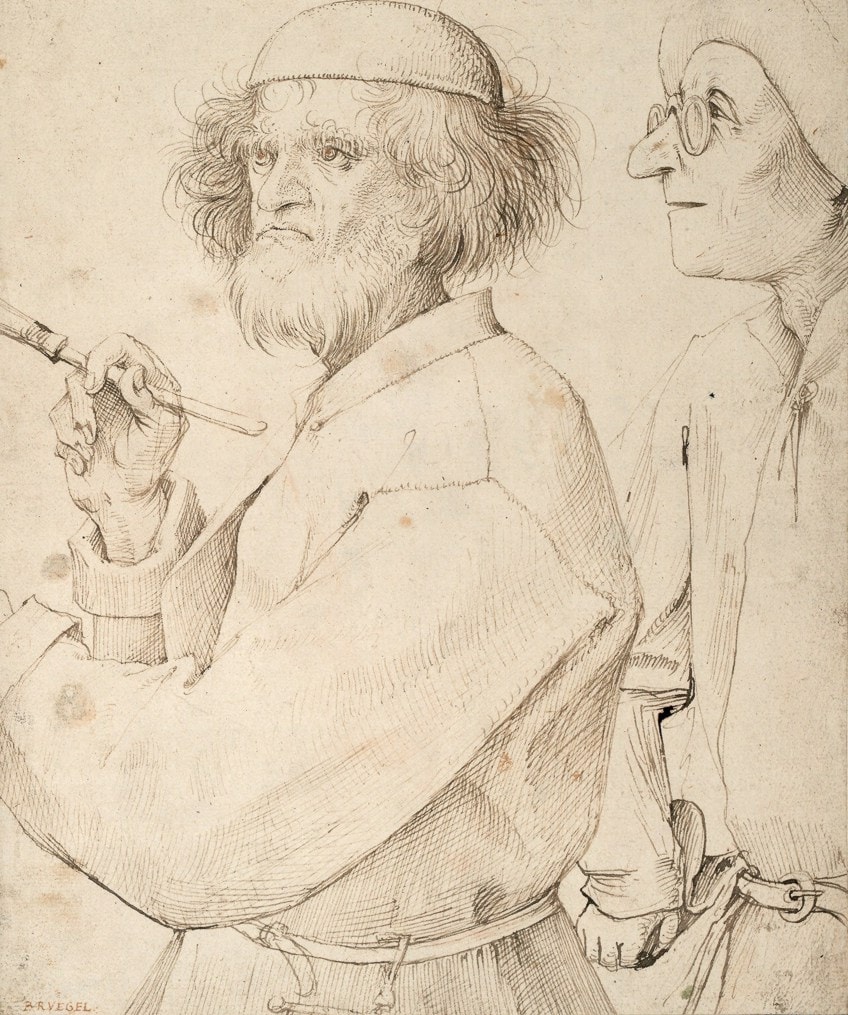
Furthermore, Bruegel left an extraordinary legacy as a Northern Renaissance painter, depicting his subject matter in such intricate details that we need to sit with each painting for a while for it to show itself to us. His paintings brim with life, adventure, and amazing narratives. There are numerous other Bruegel paintings not mentioned here and worth investigating.
From peasants, religious figures, proverbs, and mythological characters with their legs upturned, like we saw in the Fall of Icarus, Pieter Bruegel art is almost a genre of its own.
Frequently Asked Questions
What Characterized Pieter Bruegel’s Art?
The unique portrayal of perspective and scale was one of Pieter Bruegel the Elder’s primary characteristics. We will notice in many of Bruegel’s artworks that he zooms in on a scene, almost like a bird’s eye view, and his characters are smaller and distributed filling up the entire compositional space.
What Made Bruegel’s Art Different From Italian Renaissance Art?
Pieter Bruegel the Elder’s painted Genre paintings, most of his paintings focused on everyday people, objects, and places. He depicted scenes from everyday life like farming, festivities, holidays, dancing, eating, and much more. This was very different from the heroic and almost perfect scenes about religious and mythological figures from the Italian Renaissance paintings.
How Many Pieter Bruegel Paintings Are There?
It is important not to get confused with all the Bruegel artists. Pieter Bruegel the Elder was the original who had two sons called Pieter Brueghel the Younger and Jan Brueghel the Elder (note that his sons’ names are spelled with an “H”).
Isabella studied at the University of Cape Town in South Africa and graduated with a Bachelor of Arts majoring in English Literature & Language and Psychology. Throughout her undergraduate years, she took Art History as an additional subject and absolutely loved it. Building on from her art history knowledge that began in high school, art has always been a particular area of fascination for her. From learning about artworks previously unknown to her, or sharpening her existing understanding of specific works, the ability to continue learning within this interesting sphere excites her greatly.
Her focal points of interest in art history encompass profiling specific artists and art movements, as it is these areas where she is able to really dig deep into the rich narrative of the art world. Additionally, she particularly enjoys exploring the different artistic styles of the 20th century, as well as the important impact that female artists have had on the development of art history.
Learn more about Isabella Meyer and the Art in Context Team.
Cite this Article
Isabella, Meyer, “Bruegel Paintings – Exploring the Art of Pieter Bruegel the Elder.” Art in Context. October 10, 2021. URL: https://artincontext.org/bruegel-paintings/
Meyer, I. (2021, 10 October). Bruegel Paintings – Exploring the Art of Pieter Bruegel the Elder. Art in Context. https://artincontext.org/bruegel-paintings/
Meyer, Isabella. “Bruegel Paintings – Exploring the Art of Pieter Bruegel the Elder.” Art in Context, October 10, 2021. https://artincontext.org/bruegel-paintings/.


